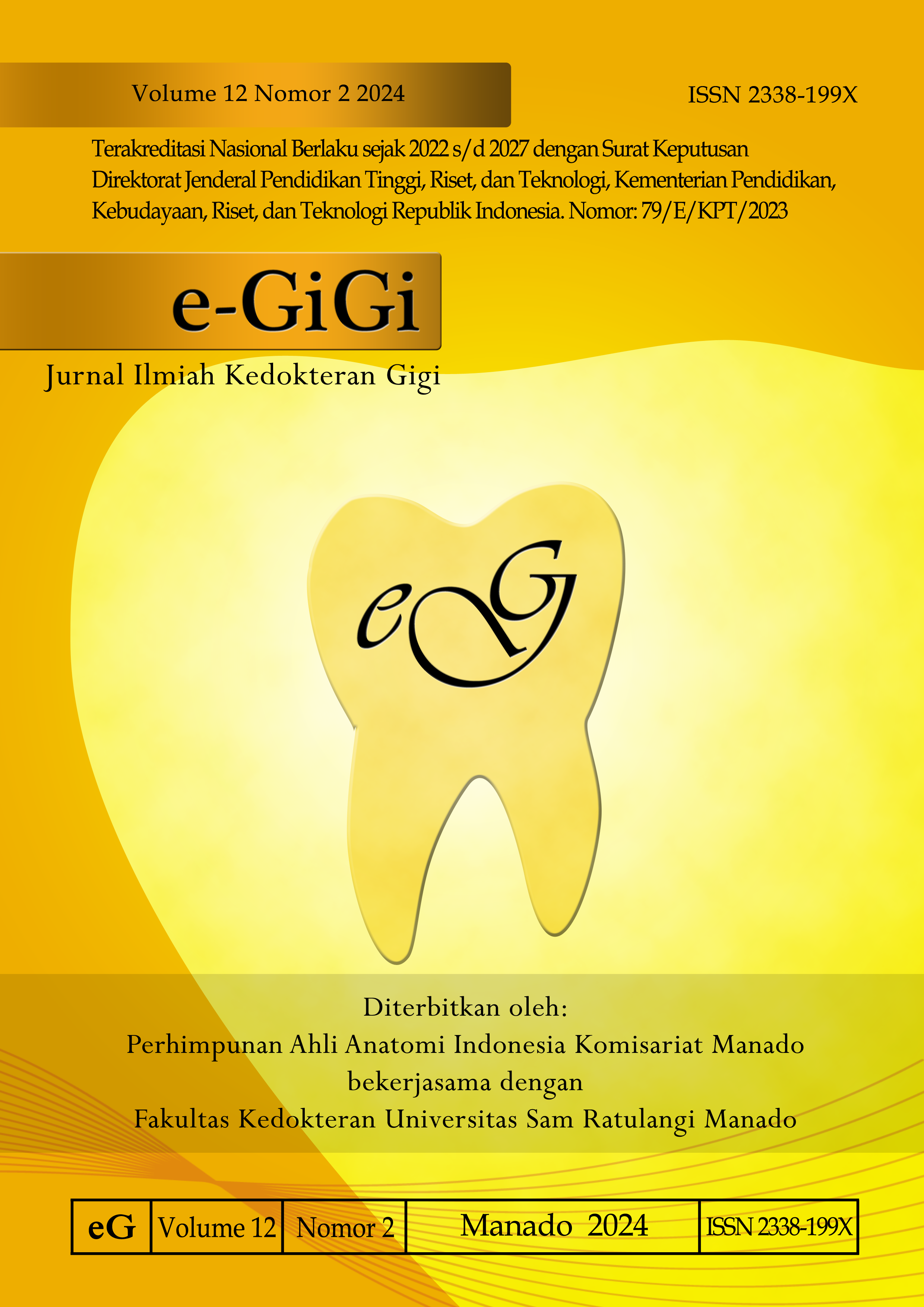Dental Profiling and Findings of Multiple Jaw Fractures in Traffic Accident Victim: A Case Report
DOI:
https://doi.org/10.35790/eg.v12i2.53455Abstract
Abstract: Motorcycle riders have a high prevalence of accident risks. These accidents can result in severe injuries and can even lead to death. The death prevalence among motorcyclists is three times higher than that of car passengers, six times higher than that of pedestrians, and almost 50 times higher than that of bus occupants. Traffic accidents can cause blunt trauma. High-speed crashes are common in polytraumatized motorcycle crashes and often display facial injuries. In this case report, the authors present a case of an accident with findings of facial trauma to the forehead, nose, cheeks, and multiple fractures of the maxilla and mandible due to a hard object impact. Dental examination revealed post-mortem tooth loss, fractures of the teeth, attrition, root remains, and visible impaction. In conclusion, craniofacial blunt trauma presents with many clinical features. The authors recommend that the finding of such cases be performed further examinations such as X-rays to gain an idea of the possible location of the fracture and to do an autopsy.
Keywords: motorcycle accident; blunt trauma; maxillary fracture; mandibular fracture
References
Kusnandar VB. Kecelakaan lalu lintas meningkat, capai 94 ribu kasus sampai September 2022. Katadata Media Network. 2022. Available from: https:// databoks.katadata.co.id/datapublish/2022/11/22/ kecelakaan-lalu-lintas-meningkat-capai-94-ribu-kasus-sampai-september-2022
Ramli R, Oxley J, Noor FM, Abdullah NK, Mahmood MS, Tajuddin AK, et al. Fatal injuries among motorcyclists in Klang Valley, Malaysia. J Forensic Leg Med. 2014;26:39–45. Available from: https://doi.org/10.1016/j.jflm.2014.06.007
Parinduri AG. Asmadi E, editor. Buku Ajar Kedokteran Forensik dan Medikolegal [Internet]. Medan: UMSU Press; 2020. Available from: http://umsupress.umsu.ac.id
Shkrum MJ, Ramsay DA. Forensic Pathology of Trauma. Common Problems for the Pathologist. Totowa, New Jersey: Humana Press; 2007. p. 405.
Ainy E, Khorshidi A, Monfared AB, Soori H, Haddadi M. Epidemiological pattern of road traffic injuries among occupants’ vehicles in 2012. J Transp Technol. 2016;06(05):277–85. Available from: http://dx.doi.org/10.4236/jtts.2016.65025
Hadi S, Hoseinian S, Ebrahimzadeh MH, Peivandi MT, Bagheri F, Hasani J, et al. Injury patterns among motorcyclist trauma patients: a cross sectional study on 4200 patients [Internet]. Arch Bone Jt Surg. 2019;7(4):367-72. Available from: http://abjs.mums.ac.irtheonlineversionofthisarticleabjs.mums.ac.ir
Nyameino S, Butt F, Guthua SW, Macigo F, Akama M. Occurrence and pattern of maxillofacial injuries caused by motorcycle crashes presenting at two major referral hospitals in Nairobi, Kenya. Craniomaxillofacial Trauma & Reconstruction Open. 2018;2(1):e9-e14. Doi:10.1055/s-0038-1660434
Granieri SS, Reitano EE, Bindi FF, Renzi FF, Sammartano FF, Cimbanassi SS, et al. Motorcycle-related trauma: effects of age and site of injuries on mortality. A single-center, retrospective study. World Journal of Emergency Surgery. 2020;15(1):18. Available from: https://doi.org/10.1186/s13017-020-00297-1
Petit L, Zaki T, Hsiang W, Leslie MP, Wiznia DH. A review of common motorcycle collision mechanisms of injury. EFORT Open Rev. 2020;5(9):544–8. Doi: 10.1302/2058-5241.5.190090.
Rothweiler R, Bayer J, Zwingmann J, Suedkamp NP, Kalbhenn J, Schmelzeisen R, et al. Outcome and complications after treatment of facial fractures at different times in polytrauma patients. Journal of Cranio-Maxillofacial Surgery. 2018;46(2):283–7. Doi: 10.1016/j.jcms.2017.11.027
Pietzka S, Kämmerer PW, Pietzka S, Schramm A, Lampl L, Lefering R, et al. Maxillofacial injuries in severely injured patients after road traffic accidents—a retrospective evaluation of the TraumaRegister DGU® 1993–2014. Clin Oral Investig. 2020;24(1):503–13. Doi: 10.1007/s00784-019-03024-6
Hoppe IC, Halsey JN, Ciminello FS, Lee ES, Granick MS. A single-center review of palatal fractures: etiology, patterns, concomitant injuries, and management. Eplasty. 2017:17:e20.
Goots A, Isa MI, Fenton TW, Wei F. Blunt force trauma in the human mandible: An experimental investigation. Forensic Sci Int: Reports. 2022;5:100252.
DiMaio VJM, Molina KD. DiMaio’s Forensic Pathology (3rd ed). Boca Raton: CRC press; 2021. Available from: https://doi.org/10.4324/9780429318764
Dettmeyer RB, Verhoff MA, Schütz HF. Forensic Medicine. Berlin, Heidelberg: Springer: 2014.
Pelletti G, Cecchetto G, Viero A, De Matteis M, Viel G, Montisci M. Traumatic fatal aortic rupture in motorcycle drivers. Forensic Sci Int. 2017;281:121–6. Available from: https://doi.org/10.1016/ j.forsciint.2017.10.038
de la Cruz RAR, Tuazon RS. Motorcycle related cranio maxillofacial injuries at a tertiary hospital in the Philippines. Philippine Journal of Otolaryngology - Head And Neck Surgery. 2016;31(2):27–30. Doi:10.32412/pjohns.v31i2.231
Manigandan T, Sumathy C, Elumalai M, Sathasivasubramanian S, Kannan A. Forensic radiology in dentistry. J Pharm Bioallied Sci. 2015;7(Suppl 1):S260-4. Doi: 10.4103/0975-7406.155944.
Downloads
Published
How to Cite
Issue
Section
License
Copyright (c) 2024 Aditia D. Yunus, Ferry P. Gultom, Ria Puspitawati, Fitri A. Sari, Eko Prastyo, Ferdy Rijaldi, Suripto Suripto

This work is licensed under a Creative Commons Attribution-NonCommercial 4.0 International License.
COPYRIGHT
Authors who publish with this journal agree to the following terms:
Authors hold their copyright and grant this journal the privilege of first publication, with the work simultaneously licensed under a Creative Commons Attribution License that permits others to impart the work with an acknowledgment of the work's origin and initial publication by this journal.
Authors can enter into separate or additional contractual arrangements for the non-exclusive distribution of the journal's published version of the work (for example, post it to an institutional repository or publish it in a book), with an acknowledgment of its underlying publication in this journal.
Authors are permitted and encouraged to post their work online (for example, in institutional repositories or on their website) as it can lead to productive exchanges, as well as earlier and greater citation of the published work (See The Effect of Open Access).






